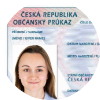
After a six-month period when only patients had access to their drug record, healthcare professionals - doctors, pharmacists and clinical pharmacists will also be able to view the patient's drug record (LZP). Pharmacists, together with other medical professions, thus gain a tool through which they can provide broader advice in the pharmacotherapy of their patients.
Inspection of HRE is possible for doctors and pharmacists from 1 June 2020, and only for those patients who have not revoked their consent to inspection of HRE. The patient has the option to have access to his / her drug record only by a pharmacist designated by him.
LZP is a comprehensive view of data that are already in the central repository of electronic recipes (CÚERp). Based on the pharmacist's approach, these data (on prescribed and dispensed medicines) will only be summarized for one patient at a time and displayed in the pharmacy information system. The data summarized in this way will not be stored either in the CAERp or in the pharmacy information system. After the pharmacist's work with LZP is finished, the preview of LZP disappears.
There will be a link between prescribed and dispensed medicines within the LZP representation. The basic period for displaying HRE will be the last 4 months, if necessary, the data will be displayed for up to 1 year (which is the maximum period for displaying information resulting from the legislation). The data will be in a form that will allow pharmacy information systems to create different views - for example, chronologically or alphabetically by drug name.
From the above information, it follows, among other things, that it will not be possible to write anything in the HRE - the HRE will only be displayed and any comments can only be written for individual eReceptions.
From 1 June 2020, patients will be able to pick up all prescribed medicines at the pharmacy using an identity card. The pharmacist reads the patient's ID card or passport number and sees all valid unissued eRecipes. Until now, it was necessary to load each eRecept separately from paper guides, text messages or e-mails.
How will the loading of eReceptions with identity card take place? Simply!
The patient presents the pharmacist with an identity card or passport. It will then no longer be necessary to show or dictate the individual identifiers of several eReceptions to collect medicines. This is especially appreciated by patients who suddenly pick up medications prescribed on multiple prescriptions.
In which cases will it not be possible to use the patient's identity card?
Dispensing will not be possible for patients who do not have an identity card or passport, which are most often children. And it will not be possible for patients who do not have a document with them, or for foreigners without permanent residence or asylum.
Loading eRecept will be possible for all types of machine readable ID cards. Today, most of the population has them. However, it should be noted that an exception applies to citizens born before 1 January 1936. These citizens do not need to have a machine-readable ID card.
Source: ČLnK

24. 4. 2024
In continuation of the tradition started last year, we have prepared a half-day lecture for foreign university students from the Netherlands on April 19, 2024...

22. 3. 2024
Whooping cough (pertussis) is a bacterial, highly contagious infectious disease that affects the respiratory tract. Strong seizures are characteristic of ...